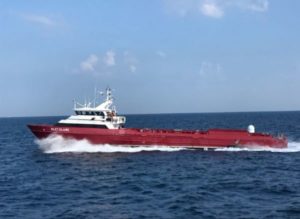A new Navy campaign plan that combines all unmanned system development is expected to be released within “just a few weeks,” the Chief of Naval Operations (CNO) said Monday.
This unmanned campaign plan “explains our taking those programs in the air, on the sea and under the sea together to try to and get us to a point by the end of the decade where we can scale and potentially, let’s say within 10 or 15 years, have a quarter of the fleet be comprised of unmanned vehicles,” CNO Adm. Mike Gilday said during the virtual Surface Navy Association symposium.

In September, Vice Adm. James Kilby, Deputy Chief of Naval Operations for Warfighting Requirements and Capabilities, N9 announced he was developing the plan with Deputy Chief of Naval Operations for Information Warfare, N2/N6, Vice Adm. Jeffrey Trussler, to develop a centralized management and leadership of enabling technologies for unmanned platforms across resource sponsors (Defense Daily, Sept. 9).
The enabling technologies include naval tactical grid, artificial intelligence and machine learning, and the Common Control System.
Also in September, Assistant Secretary of the Navy for Research, Development and Acquisition James Geurts said efforts like the unmanned campaign plan will help scale up unmanned efforts more efficiently than working separately on each platform (Defense Daily, Sept. 11).
The CNO said by the end of this decade the Navy “must deliver” on unmanned systems and put itself in a position to scale up the systems.
Gilday argued unmanned systems will be used to expand the Navy’s intelligence, surveillance and reconnaissance advantage; add depth to weapon magazines; “and they can operate inside the highly contested areas.”
“They will provide affordable solutions to grow our Navy and to provide lethal combat power,” he continued.
Gilday also noted sailors must have the confidence and skills to operate alongside the unmanned platforms at sea.
The CNO also addressed the congressional reticence in moving forward too quickly on new systems after repeated delays in the Littoral Combat Ship program.
He said he has been talking to Congress and “we are learning from mistakes we’ve made in the past, we are not wringing our hands, we are very optimistic and we’re charging forward to solve problems and to fix stuff in this decade to sustain the overmatch we have in some areas and in those areas where we’re falling behind, to close those capability gaps as quick as we can.”
“We want the Chinese reacting to us instead of our reacting to them,” Gilday added.